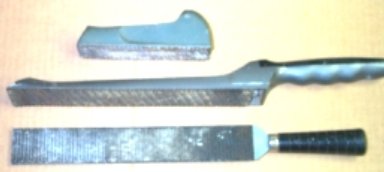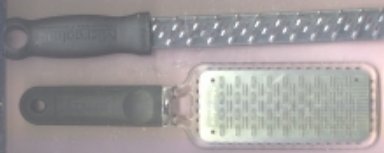Basically files are long sequential chisel teeth, arranged on a metal substrate, which are pushed along a surface with varying degrees of pressure to dig in and split away particles for removal. As a standard hand tool in metal, wood and now plastic working, many sizes, shapes, forms and coarseness have developed to shape and finish parts of almost any material and size. In the hands of a skilled craftsman almost any piece can be made, as was done by the village blacksmith and pattern maker before the machine age. Probably the most common uses in model work is finishing rough cuts with a saw, internally or evternally and removing flash and gate marks.
Due to teeth design and layout, files are usually pushed across the work piece in a direction parallel to the longitudinal center line or pointed at some small angle to the left, with a pressure toward the piece. In two hand filing, the left hand will be forward. Heavier pressure and an angle perpendicular to tooth line yields faster cutting, but often produces a rougher finish. Pointing at an angle, introduces a slicing effect with smoother finish. For straight and level finishes, file must be held level throughout stroke. By tilting gradually throughout stroke, convex curves may be achieved. The file should be lifted and not dragged on the return stroke, to prevent dulling teeth.
Draw filing is a technique used to level and smooth longer pieces, where the piece is clamped in a vise; then the file, grasped at the ends, is positioned across it and pulled, or sometimes pushed, along the piece length. Again angling the teeth to a slicing attack produces a finer finish. Usually burrs are formed along the edges, which must be removed at finishing. A common use is sharpening heavy scrapers and shears.
Since round files are usually tapered, they can be used as reamers to enlarge holes in thinner material. Pushed into hole, just short of jamming, slight twists cut similar to a reamer. With custom shapes and special teeth, brooches are a file variation used by machinists and jewelers. Normally they are pushed clean through th hole.
Often files are used with LATHES _ or other turning devices for freehand shaping, deburring, breaking edges or CHAMFERRING _ and finishing. This is normally a two hand job while holding file stationary against the turning piece, but can be done with one for smaller pieces,. Special long lathe files are offered for larger work.

Note: Adjust brightness and contrast for optimum viewing.
FILLING CHAMFER
Foredom handpiece in holder
 CAUTION: When using
lathes, arms must be bare, to avoid catching sleeves in turning parts.
CAUTION: When using
lathes, arms must be bare, to avoid catching sleeves in turning parts.
Teeth vary in size dependent on the finish and cutting speed required. Terminology varies according to area of usage. In increasing cutting speed and roughness of finish and decreasing teeth per inch (tpi), common are: dead 100+ tpi, fine 80 ,smooth 50-60, second cut 40, bastard 30, middle 25, rough 20 and rasp. Sometimes they are numbered for finer cuts in jeweler's files. Teeth are normally set at an angle of 75 ° to the length center line. Faster, double cut files have two sets of crossing teeth set at center line angles of 80 ° on one side and 45 ° on the other. Due to their rapid cutting, rasps are sometimes an exception, in that teeth may be short and individual, spread in various patterns over the face to reduce clogging. Normally they are used on softer materials. Cobblers use them to shape leather and wooden heels and smithies trim horses hooves with them during shoeing .
Among the more common files sizes, lengths run from 3" needle or jeweler's to about 12". Widths may approach 2". Most are tapered, some down to a very sharp point. Thickness also vary, with some thin enough to be flexed.
Of more interest, cross sections vary quite extensively. Common in larger sizes are flat, round or rat-tail, half round, tri-square or triangular , square and knife. Some have toothless or safe faces to prevent cutting of adjacent obstructions. In jeweler's or swiss pattern files, the variations are extended to well over 30 shapes. Each has a particular advantage in a specific case. A large percentage taper to fine points, hence the common appellation, needle files.
Jeweler's files have integral round shaft handles, while larger files have tapered tangs, which can be wedged into large handles for heavy work. Although extension handles are available for jeweler's sizes, they are hardly warranted, since heavy force is not usually required and they tend to be awkward enough to destroy a fine touch.
Most useful for modelling, are the jeweler's swiss pattern . Particularly on metal, they are almost indispensable for cleaning flash, truing edges, fitting parts and minor shaping. With the newer more highly detailed castings and one piece bodies with everything cast on, many small holes must be cleaned and shaped. The smallest size files can fit almost anything. There are several cuts including rasps. Finer cuts are better on plastic for smoother finish, but tend to load faster, requiring more frequent carding.
Not too much larger are fine ignition files, available when cars still used points, and warding files. These are useful for longer truing and larger work. In this size area many semi-flexible fingernail files with finer teeth.

Note: Adjust brightness and contrast for optimum viewing.
SMALLER FILES





